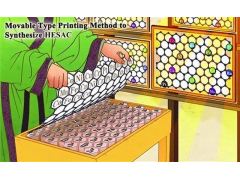Movable type printing is one of the four great inventions of ancient China, which realizes the printing of various characters and books by arranging and combining movable wooden types.
Inspired by movable-type printing,The team of Professor Tian Xinlong of Hainan University proposed a universal strategy for the preparation of precious metal monatomic catalysts, and showed excellent activity of hydrogen oxidation and hydrogen precipitation[1].
Specifically, the researchers used precisely synthesized monoatomic precursors of multiple precious metals, including palladium (Pd), platinum (Pt), rhodium (Rh), iridium (Ir), ruthenium (Ru), as a template for "movable type," using porous carbon carriers as "paper."
Through high temperature roasting, the precious metal single atoms in the precursor were successfully printed on the carbon support "point to point", and finally the precious metal single atom catalyst (SA-PM/CNs) was synthesized.

FIG. "Movable Type Printing" strategy to synthesize polymetallic Active center single-atom catalyst (Source: Hainan University)
This universal catalyst synthesis strategy effectively avoids the agglomeration of precious metal atoms during the preparation process, and can ensure the high dispersion of precious metal atoms.The synthesis strategy has universality, expansibility and the ability of large-scale preparation, which shows great industrialization potential.
Reviewers commented on the study that the universal strategy can not only prepare precious metal monatomic catalysts, but also extend to non-precious metal catalysts, and has application potential in different electrocatalytic systems such as oxygen reduction reactions, oxygen evolution reactions, and hydrogen fuel cells.

Photo Tian Xinlong (Source: Tian Xinlong team)
Tian Xinlong pointed out that the synthesis of a variety of single-atom catalysts can be applied to optoelectrocatalysis, metal-air batteries, hydrogen fuel cells and other fields. At present, the catalyst can achieve kilogram synthesis in the laboratory, and the performance is good uniformity.
This method not only provides a new direction for the synthesis of single atoms, but also opens up a new way for the design and synthesis of novel multi-active centers and multi-functional single atom catalysts. "This universal synthesis strategy provides an efficient and controllable preparation method for the study of monatomic catalysts, and also provides a reference for the synthesis of other monatomic catalysts." 'he said.

The development of hydrogen energy industry is an important direction of the world's energy technology change
The pursuit of clean, renewable energy and efficient energy utilization and transformation is a major demand for the sustainable development of the world economy and society. The energy attribute of hydrogen is a clean, efficient and renewable secondary energy source, which has important application prospects in energy transformation, storage, transportation and other fields.
According to the International Hydrogen Energy Council, "By 2050, the proportion of hydrogen energy in global energy will reach 18%, and the hydrogen energy industry chain will create 30 million jobs, create 2.5 trillion US dollars of output value, and reduce 6 billion tons of carbon dioxide emissions [2]."
As countries around the world move towards cleaner, low-carbon and intelligent energy, developing and strengthening the construction of hydrogen energy industry has become one of the important directions of the current global energy technology change. This is not only a specific path to achieve China's "double carbon" goal, but also an important measure to build a manufacturing power, build a new energy system, and build a modern industrial system.
By 2023, China's hydrogen production will exceed 40 million tons, ranking first in the world. However, this hydrogen basically comes from hydrogen production from fossil fuels and industrial by-products. Among them, the green hydrogen produced by electrolytic water using renewable energy accounts for less than 1%; On the other hand, China still has great problems such as abandoning wind and abandoning light.

Diagram of hydrogen energy application scenarios (Source: The team)
How to use green hydrogen as a medium to consume excess renewable energy is one of the key directions for scientists to explore. Catalysts play an important role in the process of efficient hydrogen energy conversion.
However, under the actual operating conditions, the catalyst is faced with the corrosive environment of strong acid and alkali, as well as the operating environment of high voltage and high current, which is easy to cause the catalyst corrosion instability, reduce the stability and reduce the life of hydrogen energy devices.

The controlled synthesis of multiple precious metal single atoms is realized
At present, the development of low-cost, high-performance and long-life hydrogen electrocatalytic materials and devices is also one of the challenges facing the development of hydrogen energy industry.
To solve this problem, Tian Xinlong's team has been conducting research on low platinum precious metal catalysts, and has achieved a series of innovative research results, including one-dimensional hollow nanocage catalysts with high stability, core-shell structures, nanocluster catalysts, etc. [3-7].
Recently, single-atom catalysts have shown excellent catalytic activity and application potential in many catalytic reactions, mainly due to their intrinsic advantages such as high atomic utilization, clear and uniform active site, and unique electronic structure.
Among them, the precious metal single atom catalyst can limit the use of precious metals, while maintaining its high activity and stability, which is just in line with the research direction of low platinum catalysts in this research group.

FIG. Synthesis of five SA-PM/CNs (PM = Pd, Pt, Rh, Ir and Ru) (Source: Carbon Energy)
In the process of preparation, precious metal atoms are easy to agglomerate to form particles, so how to effectively ensure the dispersion of precious metal single atoms is a big problem.
At the same time, the properties of different elements of precious metals are very different, so it is difficult to achieve the controlled synthesis of different kinds of precious metal monatomic catalysts by a single method, which greatly limits the research and application of monatomic catalysts.
The research group found that the use of carbon nitride (C3N4) carriers can achieve a better effect in blocking the aggregation of metal atoms. In addition, a nitrogen source can be provided to fix the metal atoms, thus realizing the controlled preparation of the precious metal monatomic catalyst.
The researchers confirmed that SA-Pd/CN, SA-Pt/CN and SA-Ru/CN exhibited catalytic activity and selectivity comparable to commercial catalysts in hydrogen precipitation reactions.

FIG. Morphological characteristics of SA-PM/CNs (Source: Carbon Energy)
In addition, in the selection of printing carriers, although the final obtained are the precious metal single atoms responsible for porous carbon carriers, different carbon sources have a greater impact on the loading capacity of precious metal single atoms.
"Through many attempts, we chose the carbon source polydopamine, which has a high nitrogen content and is easy to form more defect sites at high temperatures, to provide more anchor sites for the precious metal single atoms," Tian said.
In general, the researchers have developed a universal preparation strategy for precious metal monatomic catalysts by actively searching for material carriers of atomically dispersed metals, while continuously optimizing the preparation process.

FIG. Related Papers (Source: Carbon Energy)
In the end, The paper is titled "General approach for atomically dispersed precious metal catalysts toward hydrogen. reaction) was published in Carbon Energy [1].
Li Ruisong, Assistant researcher at Hainan University, is the first author of the paper, and Deng Peilin, Associate professor at Hainan University, Kang Zhenye and Tian Xinlong are co-corresponding authors.
At present, multi-metal monatomic catalysts have shown better performance than mono-metal monatomic catalysts. However, the synthesis of catalysts with polymetallic active centers is one of the challenges. based on this, their next research plan is to explore higher performance multi-component monatomic catalysts to achieve accurate synthesis of binary or multi-component monatomic catalysts.
"We validate the utility of our catalyst by conducting tests at the actual hydrogen device level and feed the results back into the catalyst design to further optimize synthesis and mass production methods." Tian Xinlong said.

Dedicated to catalyst scale-up preparation and kilogram testing
At present, Tian Xinlong serves as vice president, professor and doctoral supervisor of the College of Marine Science and Engineering of Hainan University. The research direction of the research group focuses on the field of Marine energy and resources development, including seawater hydrogen production, seawater batteries, seawater uranium/lithium extraction and Marine energy equipment.
based on a series of excellent scientific research achievements, he was selected as one of the "35 Technological Innovators under 35" in Asia Pacific Region in 2023 by MIT Technology Review, and was also selected as a national Young Top talent; The Marine clean energy innovation team he is responsible for also won the 2023 "Hainan Youth May Fourth Medal Collective".

Photo Tian Xinlong team photo (Source: The team)
In our previous research, we developed a new method for coordination and stress effect synergistic regulation of low platinum alloy catalysts based on corrosion induction strategy. One-dimensional series nanocage low platinum catalyst has excellent electrocatalytic performance, and the output power and service life of hydrogen fuel cells are greatly improved by this catalyst.
In addition, Tian Xinlong's team also developed a new platinum based core-shell structure catalyst system based on ultra-thin platinum layers, revealing the stability regulation mechanism of core-shell structure catalysts. In addition, the stability of the catalyst is verified according to the actual test of direct electrolysis of seawater for hydrogen production and seawater electrolytic cell.

FIG. Multiple new high-performance catalyst systems (Source: The team)
Tian Xinlong believes that in the choice of research direction, it should focus on the key scientific problems and technical problems, but also serve the local economic development and needs, and achieve "characteristics to win."
Therefore, they are also developing the direct electrolysis of seawater hydrogen production technology. As the "dual carbon" goal approaches and is implemented, the huge amount of fresh water purification and electricity demand will put serious social and environmental pressures on many regions.
Coupled with Marine renewable energy and direct electrolysis of seawater hydrogen production technology, it will be an ideal way to produce large-scale green hydrogen. "Converting blue energy into a stable hydrogen energy supply system through direct electrolytic seawater hydrogen production technology, serving China's strategy of becoming a maritime power, will be our future struggle and development goal." Tian Xinlong said.
In addition to basic research, the industrialization of technology is also a goal that Tian Xinlong is committed to promoting. It is reported that the research group and the national energy group Ledong Power Generation has established a Marine clean energy research institute, one of the main research contents is to magnify the preparation of catalysts with application prospects to achieve pilot and kilogram tests.

Photo: Tian Xinlong team members and State Power Investment (Lingshui) Smart Energy Co., LTD. Hydrogen energy technology exchange (Source: The team)
In addition, they and the State Power Investment Group (Lingshui) Smart Energy Co., Ltd. jointly carried out research and development of new hydrolytic hydrogen production efficient membrane electrode module and its basic research, will be volatility photovoltaic and wind power hydrogen production, hydrogen storage and hydrogen energy vehicle operation demonstration system.
"We firmly believe that with the approach of China's 'dual carbon' goal and the implementation of the policy, the hydrogen energy industry will achieve greater development," Tian said.
Reference materials:
1. Li, R., Wu, D., Rao, P., Deng, P.*, Li, J., Luo, J., Huang W., Chen, Q., Kang, Z.*, Shen Y., Tian, X.*, General approach for atomically dispersed precious metal catalysts toward hydrogen reaction. Carbon Energy 2023, 5, e294. https://doi.org/10.1002/cey2.294
2.https://hydrogencouncil.com/en/hydrogen-scaling-up-new-roadmap-launches-at-cop-23/
3. Tian, X.#, Zhao, X.#, Su, Y.#, Wang, L., Wang, H., Dang, D., Liu, H., Hensen, W., Lou, D.*, Xia, B.*, Engineering bunched Pt-Ni alloy nanocages for efficient oxygen reduction in practical fuel cells. Science 2019, 366, 850. https://www.science.org/doi/10.1126/science.aaw7493
4. Rao, P., Deng, Y., Fan, W., Luo, J., Deng, P., Li, J., Shen, Y., Tian, X.*, Movable type printing method to synthesize high-entropy single-atom catalysts, Nature Communications 2022, 13, 5071.
https://doi.org/10.1038/s41467-022-32850-8
5. Xu, Y., Wu, D., Zhang, Q., Rao, P., Deng, P.*, Tang, M.; Li, J., Hua, Y., Wang, C., Zhong, S., Jia, C., Liu, Z., Shen, Y., Gu, L.*, Tian, X.*,Liu, Q*. Regulating Au coverage for the direct oxidation of methane to methanol. Nature Communications 2024, 15, 564.
https://www.nature.com/articles/s41467-024-44839-6
6. Song, Y., Zheng, X., Yang, Y., Liu, Y.*, Li, J., Wu, D., Liu, W., Shen, Y., Tian, X. *. Heterojunction Engineering of Multinary metal Sulfide-based Photocatalysts for Efficient Photocatalytic Hydrogen Evolution. Advanced Materials 2023, 2305835.
https://doi.org/10.1002/adma.202305835
7. Tian, X., Lu, X. F., Xia, B.*, Lou, X.*, Advanced Electrocatalysts for the Oxygen Reduction Reaction in Energy Conversion Technologies. Joule 2020, 4, 45-68.
https://doi.org/10.1016/j.joule.2019.12.014
8. Zheng, X., Song, Y., Liu, Y.*, Yang, Y., Wu, D., Yang, Y., Feng, S., Li, J., Liu, W., Shen, Y., Tian, X.*, ZnIn2S4-based photocatalysts for photocatalytic hydrogen evolution via water splitting, Coordination Chemistry Reviews, 2023, 475, 214898. https://doi.org/10.1016/j.ccr.2022.214898







